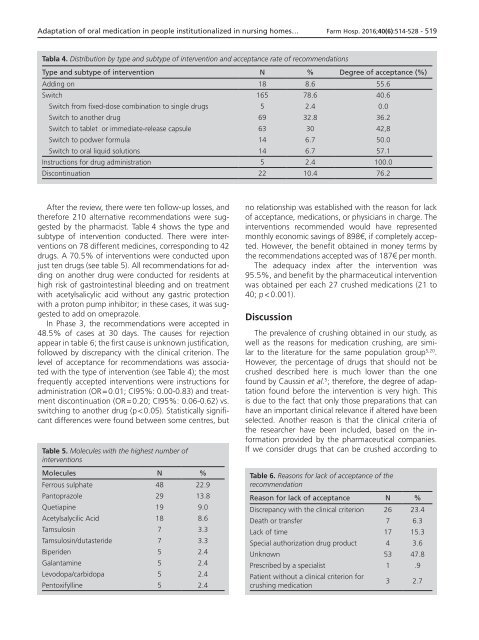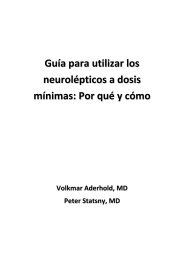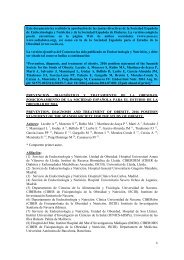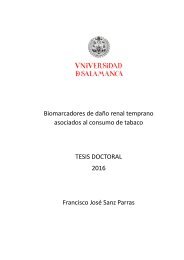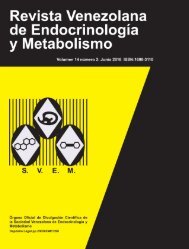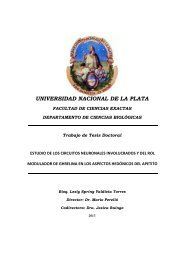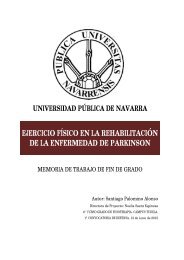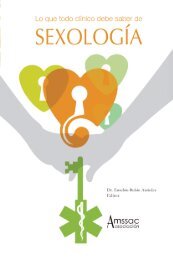Noviembre-Diciembre
156_v40n6(1)
156_v40n6(1)
You also want an ePaper? Increase the reach of your titles
YUMPU automatically turns print PDFs into web optimized ePapers that Google loves.
Adaptation of oral medication in people institutionalized in nursing homes… Farm Hosp. 2016;40(6):514-528 - 519<br />
Tabla 4. Distribution by type and subtype of intervention and acceptance rate of recommendations<br />
Type and subtype of intervention N % Degree of acceptance (%)<br />
Adding on 18 8.6 55.6<br />
Switch 165 78.6 40.6<br />
Switch from fixed-dose combination to single drugs 5 2.4 0.0<br />
Switch to another drug 69 32.8 36.2<br />
Switch to tablet or immediate-release capsule 63 30 42,8<br />
Switch to podwer formula 14 6.7 50.0<br />
Switch to oral liquid solutions 14 6.7 57.1<br />
Instructions for drug administration 5 2.4 100.0<br />
Discontinuation 22 10.4 76.2<br />
After the review, there were ten follow-up losses, and<br />
therefore 210 alternative recommendations were suggested<br />
by the pharmacist. Table 4 shows the type and<br />
subtype of intervention conducted. There were interventions<br />
on 78 different medicines, corresponding to 42<br />
drugs. A 70.5% of interventions were conducted upon<br />
just ten drugs (see table 5). All recommendations for adding<br />
on another drug were conducted for residents at<br />
high risk of gastrointestinal bleeding and on treatment<br />
with acetylsalicylic acid without any gastric protection<br />
with a proton pump inhibitor; in these cases, it was suggested<br />
to add on omeprazole.<br />
In Phase 3, the recommendations were accepted in<br />
48.5% of cases at 30 days. The causes for rejection<br />
appear in table 6; the first cause is unknown justification,<br />
followed by discrepancy with the clinical criterion. The<br />
level of acceptance for recommendations was associated<br />
with the type of intervention (see Table 4); the most<br />
frequently accepted interventions were instructions for<br />
administration (OR = 0.01; CI95%: 0.00-0.83) and treatment<br />
discontinuation (OR = 0.20; CI95%: 0.06-0.62) vs.<br />
switching to another drug (p < 0.05). Statistically significant<br />
differences were found between some centres, but<br />
Table 5. Molecules with the highest number of<br />
interventions<br />
Molecules N %<br />
Ferrous sulphate 48 22.9<br />
Pantoprazole 29 13.8<br />
Quetiapine 19 9.0<br />
Acetylsalycilic Acid 18 8.6<br />
Tamsulosin 7 3.3<br />
Tamsulosin/dutasteride 7 3.3<br />
Biperiden 5 2.4<br />
Galantamine 5 2.4<br />
Levodopa/carbidopa 5 2.4<br />
Pentoxifylline 5 2.4<br />
no relationship was established with the reason for lack<br />
of acceptance, medications, or physicians in charge. The<br />
interventions recommended would have represented<br />
monthly economic savings of 898€, if completely accepted.<br />
However, the benefit obtained in money terms by<br />
the recommendations accepted was of 187€ per month.<br />
The adequacy index after the intervention was<br />
95.5%, and benefit by the pharmaceutical intervention<br />
was obtained per each 27 crushed medications (21 to<br />
40; p < 0.001).<br />
Discussion<br />
The prevalence of crushing obtained in our study, as<br />
well as the reasons for medication crushing, are similar<br />
to the literature for the same population group 5,20 .<br />
However, the percentage of drugs that should not be<br />
crushed described here is much lower than the one<br />
found by Caussin et al. 5 ; therefore, the degree of adaptation<br />
found before the intervention is very high. This<br />
is due to the fact that only those preparations that can<br />
have an important clinical relevance if altered have been<br />
selected. Another reason is that the clinical criteria of<br />
the researcher have been included, based on the information<br />
provided by the pharmaceutical companies.<br />
If we consider drugs that can be crushed according to<br />
Table 6. Reasons for lack of acceptance of the<br />
recommendation<br />
Reason for lack of acceptance N %<br />
Discrepancy with the clinical criterion 26 23.4<br />
Death or transfer 7 6.3<br />
Lack of time 17 15.3<br />
Special authorization drug product 4 3.6<br />
Unknown 53 47.8<br />
Prescribed by a specialist 1 .9<br />
Patient without a clinical criterion for<br />
crushing medication<br />
3 2.7


